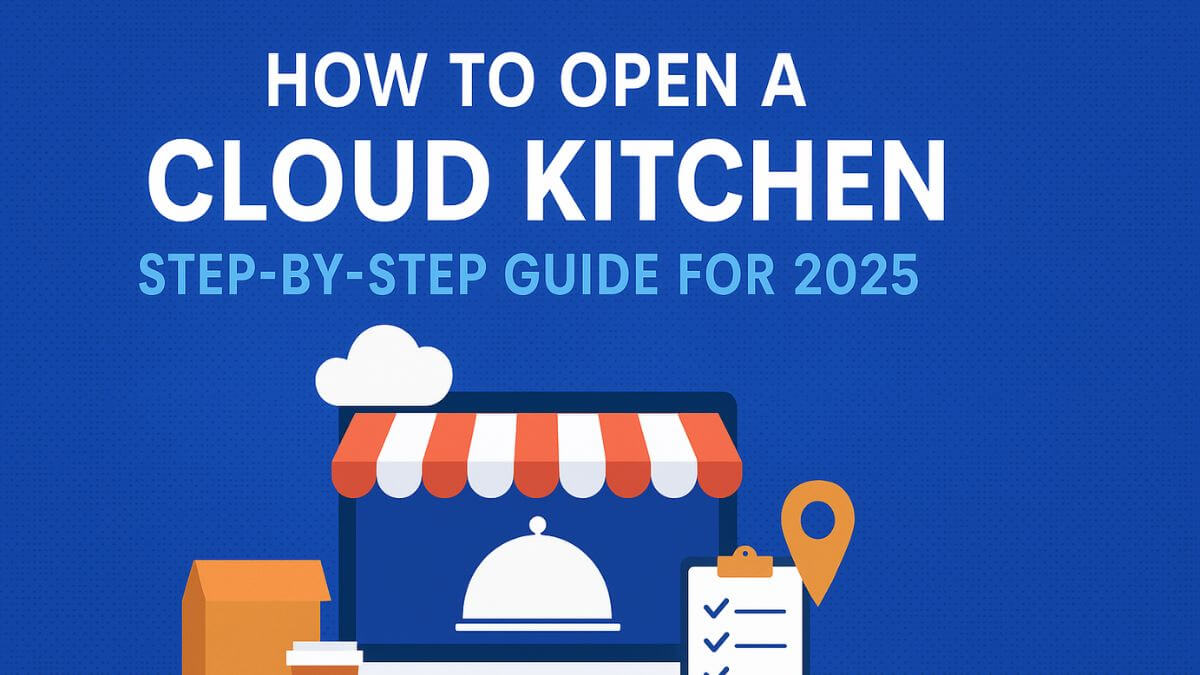The food industry is evolving, and cloud kitchens, also known as ghost kitchens, have emerged as a cost-effective and profitable alternative to traditional restaurants. With lower overhead costs and the growing demand for online food delivery, opening a cloud kitchen can be a lucrative venture. In this guide, we’ll how to open a cloud kitchen through every step of launching a successful cloud kitchen business in 2025.
What is a Cloud Kitchen?
A cloud kitchen is a delivery-only restaurant that operates without a physical dining space. These kitchens rely on online orders through food delivery platforms like Swiggy, or Zomato. They may run multiple brands under one kitchen or serve as a commissary kitchen for other food businesses.
Advantages of a Cloud Kitchen
Starting a cloud kitchen comes with several benefits, including:
- Lower Operational Costs: No need for a dine-in space, reducing rent and utilities.
- Higher Profit Margins: Focus on food production without service staff costs.
- Flexibility & Scalability: Easily expand by adding new virtual restaurant brands.
- Faster Setup & Launch: Can be operational within a few weeks compared to traditional restaurants.
- Increased Online Visibility: Leverages food delivery platforms for broader customer reach.
- Data-Driven Decisions: Analytics tools help optimize menu performance and customer preferences.
- Reduced Food Wastage: It often have optimized inventory management, reducing waste and increasing profitability.
Why Start a Cloud Kitchen in 2025?
- Lower Investment: No need for a dine-in space reduces real estate and operational costs.
- Booming Online Food Delivery Market: The global food delivery industry is expected to reach $500+ billion by 2025.
- Higher Profit Margins: With optimized operations and bulk ingredient purchasing, profit margins are better than traditional restaurants.
- Scalability: Easily expand by adding new virtual restaurant brands without additional infrastructure.
- Technology-Driven Operations: Automation tools and AI-powered analytics help streamline processes and maximize profits.
Step1: Conduct Market Research
Before setting up your cloud kitchen, analyze the market to identify:
- Target Audience: Understand customer preferences and dining habits in your location.
- Competitor Analysis: Study existing cloud kitchens and their best-selling dishes.
- Trending Cuisines: Identify high-demand food categories like healthy meals, vegan options, or comfort food.
- Local Food Regulations: Understand licensing requirements to ensure compliance.
Step2: Choose the Right Business Model
There are different cloud kitchen models to consider:
- Independent Cloud Kitchen: A single kitchen serving one brand.
- Multi-Brand Cloud Kitchen: A single kitchen operating multiple virtual restaurant brands.
- Aggregator-Owned Cloud Kitchen: Operated by third-party platforms like Swiggy Access or zomato Editions.
- Co-Working Cloud Kitchens: Shared spaces used by multiple food brands.
- Franchise-Based Cloud Kitchen: A model where businesses operate under an existing brand’s cloud kitchen framework.
Step3: Create a Solid Business Plan
Your business plan should include:
- Concept & Menu: Define your niche and menu offerings.
- Investment & Budget: Calculate startup costs, equipment, licensing, and marketing expenses.
- Revenue Model: Pricing, order volume expectations, and profit margins.
- Operational Workflow: Staff requirements, order handling, and food preparation processes.
- Technology Integration: List digital tools for order tracking, customer engagement, and kitchen management.
Step4: Find the Perfect Location
- Choose a strategic location with high demand and easy access for delivery services.
- Look for a commercial kitchen space with affordable rent and necessary permits.
- Consider renting a shared kitchen if you have limited funds.
- Ensure that the location supports delivery logistics and fast service times.
Step5: Obtain Licenses & Permits
- Food Business License (FSSAI/USDA/Local Authority)
- Health & Safety Permits
- Fire Safety Certificate
- GST/VAT Registration
- Trade License
- Insurance for Business & Employees
- Waste Disposal & Environmental Permits
check out Documents Required for FSSAI License
Step6: Set Up Your Kitchen & Equipment
- Essential kitchen appliances include ovens, fryers, refrigerators, and food processors.
- Use high-quality packaging materials for safe and appealing food delivery.
- Implement food safety protocols to maintain hygiene standards.
- Consider automation tools like robotic chefs or smart cooking devices to improve efficiency.
- Invest in energy-efficient kitchen equipment to reduce long-term costs.
Step7: Develop a Killer Menu
- Design a delivery-optimized menu with dishes that travel well.
- Use seasonal ingredients to reduce costs and enhance freshness.
- Offer customization options to increase customer engagement.
- Utilize data analytics to track popular menu items and remove low-performing dishes.
Step8: Partner with Online Food Delivery Platforms
- List your business on Swiggy and Zomato etc.
- Optimize your restaurant profile with high-quality images and compelling descriptions.
- Monitor reviews and ratings to improve customer trust and satisfaction.
- Offer exclusive platform deals to attract more orders.
Step9: Invest in Digital Marketing
- SEO & Content Marketing: Create a blog about food trends, health benefits, and recipe ideas.
- Social Media Marketing: Leverage Instagram, Facebook, and YouTube for engagement.
- Google My Business & Local SEO: Optimize your listing for better visibility.
- Influencer & Food Blogger Collaborations: Boost brand awareness with sponsored reviews. check out the Influencer Outreach Guide: Strategies, Tools, and Best Practices
- Paid Ads: Use Facebook & Google Ads for targeted promotions.
- Email & SMS Marketing: Send personalized offers and updates to customers.
Step10: Streamline Operations with Technology
- Use a POS system for efficient order management.
- Implement inventory management software to track ingredient usage.
- Automate order processing with AI chatbots and cloud-based kitchen management tools.
- Leverage delivery route optimization software to reduce delivery times and costs.
- Use customer relationship management (CRM) software to analyze order history and improve engagement.
Step11: Focus on Customer Retention & Growth
- Introduce loyalty programs and discounts for repeat customers.
- Encourage customer feedback to improve service quality.
- Expand menu options based on seasonal trends and demand.
- Scale operations by launching new cloud kitchen locations or virtual brands.
- Offer subscription-based meal plans for regular customers.
Conclusion
Starting a cloud kitchen in 2025 is a profitable business opportunity if done right. By following this guide and leveraging the right SEO strategies, you can ensure your cloud kitchen ranks higher on search engines, attracts more customers, and maximizes profits.
FAQs
A: The cost varies depending on location and equipment but typically ranges from ₹5 lakh to ₹20 lakh
A: Yes, a commercial space is required to obtain health and food safety permits.
A: Yes! Many businesses operate multiple virtual brands from a single kitchen to maximize revenue.

MoneyMantra, is a passionate content creator with over 5 years of experience in writing about the intersection of technology, business, finance, education, and more. With a deep understanding of how these fields empower both individuals and businesses





